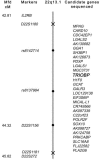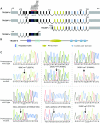Mutations in TRIOBP, which encodes a putative cytoskeletal-organizing protein, are associated with nonsyndromic recessive deafness
- PMID: 16385457
- PMCID: PMC1380211
- DOI: 10.1086/499164
Mutations in TRIOBP, which encodes a putative cytoskeletal-organizing protein, are associated with nonsyndromic recessive deafness
Abstract
In seven families, six different mutant alleles of TRIOBP on chromosome 22q13 cosegregate with autosomal recessive nonsyndromic deafness. These alleles include four nonsense (Q297X, R788X, R1068X, and R1117X) and two frameshift (D1069fsX1082 and R1078fsX1083) mutations, all located in exon 6 of TRIOBP. There are several alternative splice isoforms of this gene, the longest of which, TRIOBP-6, comprises 23 exons. The linkage interval for the deafness segregating in these families includes DFNB28. Genetic heterogeneity at this locus is suggested by three additional families that show significant evidence of linkage of deafness to markers on chromosome 22q13 but that apparently have no mutations in the TRIOBP gene.
Figures





References
Web Resources
-
- Center for Medical Genetics, Marshfield Medical Research Foundation, http://research.marshfieldclinic.org/genetics/
-
- GenBank, http://www.ncbi.nlm.nih.gov/Genbank/ (for TRIOBP1 [accession number NM_007032], mRNAs for TRIOBP [accession numbers AB051449 and AK096634], TRIOBP-6 [accession number DQ228005], TRIOBP-3 [accession number DQ228003], TRIOBP-4 [accession number DQ228004], Triobp-3 [accession number DQ228000], Triobp-4 [accession number DQ228002], and Triobp-5 [accession number DQ228001])
-
- Hereditary Hearing Loss Homepage, http://webhost.ua.ac.be/hhh/
-
- Online Mendelian Inheritance of Man (OMIM), http://www.ncbi.nlm.nih.gov/Omim/ (for WSIV)
References
-
- Ahmed ZM, Riazuddin S, Ahmad J, Bernstein SL, Guo Y, Sabar MF, Sieving P, Riazuddin S, Griffith AJ, Friedman TB, Belyantseva IA, Wilcox ER (2003) PCDH15 is expressed in the neurosensory epithelium of the eye and ear and mutant alleles are responsible for both USH1F and DFNB23. Hum Mol Genet 12:3215–322310.1093/hmg/ddg358 - DOI - PubMed
-
- Ahmed ZM, Smith TN, Riazuddin S, Makishima T, Ghosh M, Bokhari S, Menon PS, Deshmukh D, Griffith AJ, Riazuddin S, Friedman TB, Wilcox ER (2002) Nonsyndromic recessive deafness DFNB18 and Usher syndrome type IC are allelic mutations of USHIC. Hum Genet 110:527–53110.1007/s00439-002-0732-4 - DOI - PubMed
Publication types
MeSH terms
Substances
Grants and funding
LinkOut - more resources
Full Text Sources
Medical
Molecular Biology Databases
Research Materials

